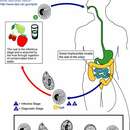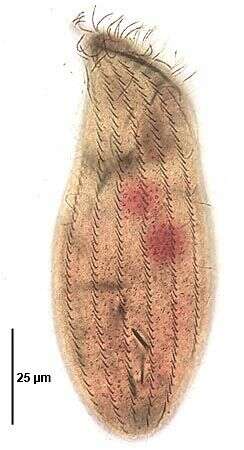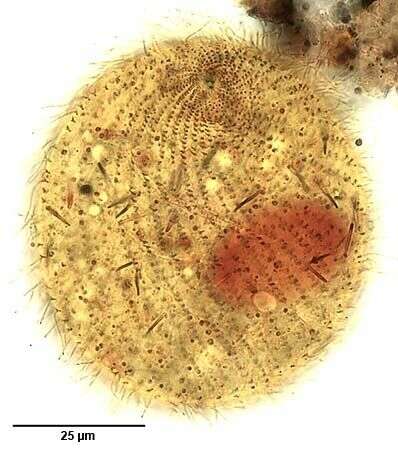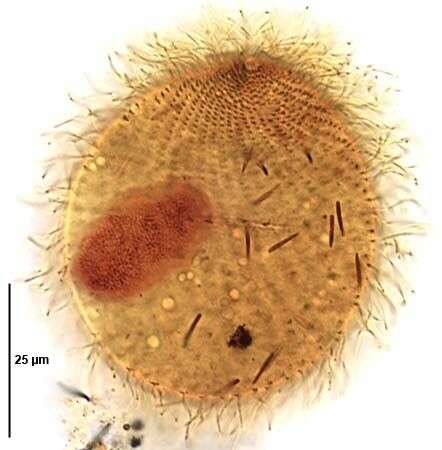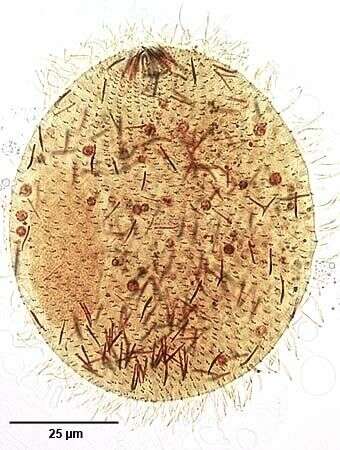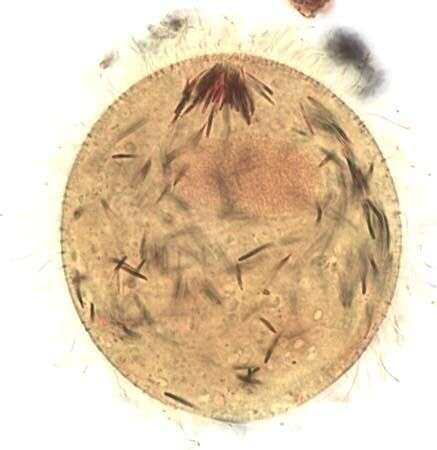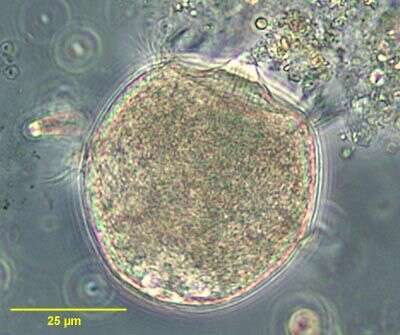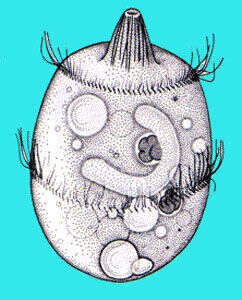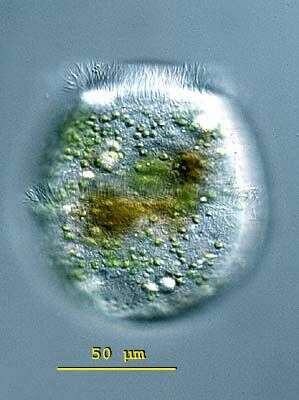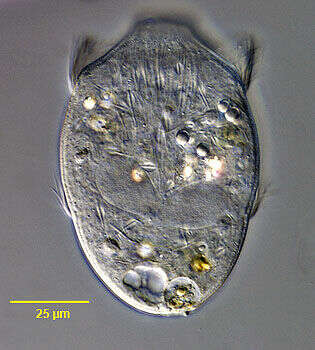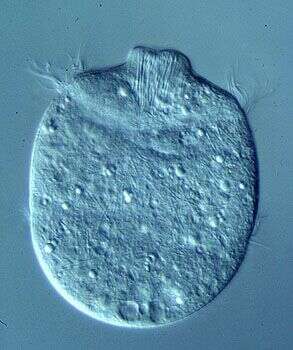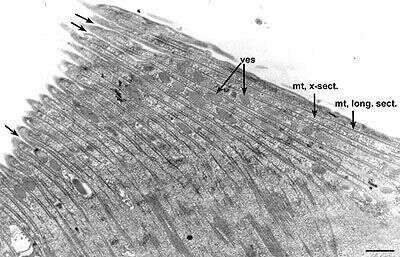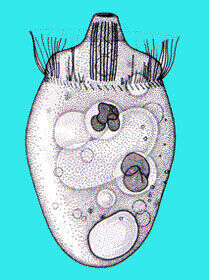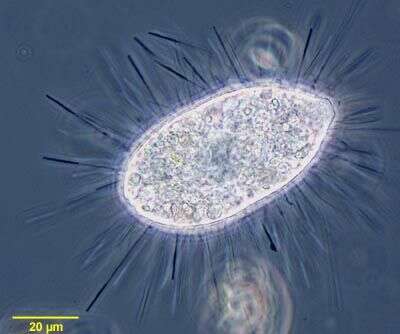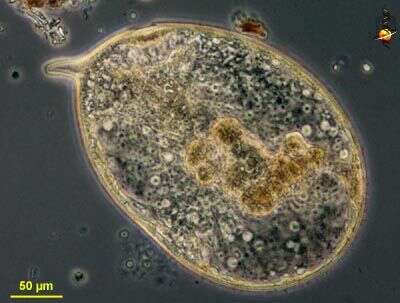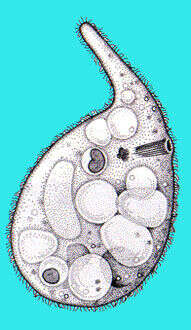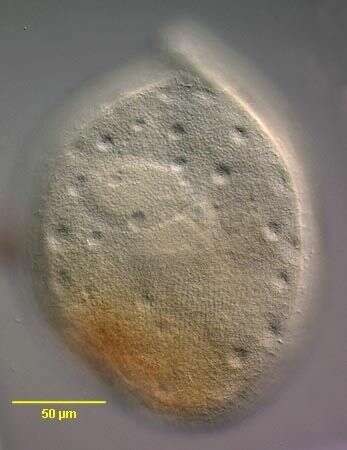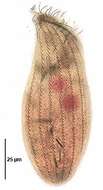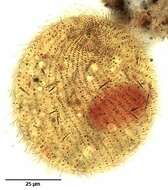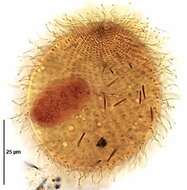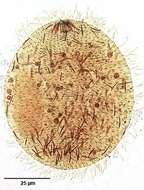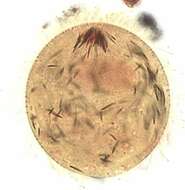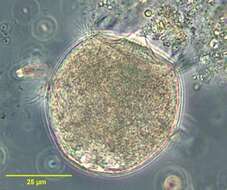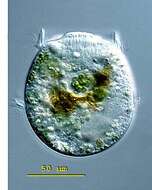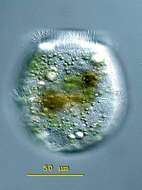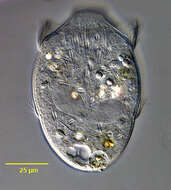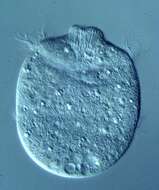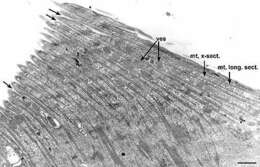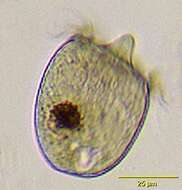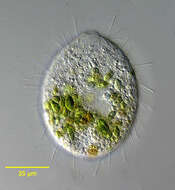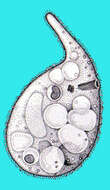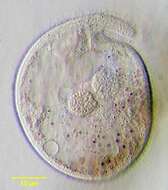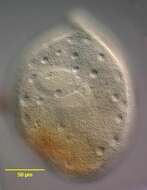-
Ventral infraciliature of Acineria incurvata DUJARDIN,1841, a pleurostomatid ciliate found in heavily polluted freshwater and marine habitats. Collected from effluent of a protein skimmer at a commercial saltwater aquarium in Boise,Idaho. January 2007.Stained by a silver carbonate technique adapted for marine ciliates (Ma,H. et al.An Improved Silver Carbonate Impregnation for Marine Ciliated Protozoa.Acta Protozool.42:161â164;2003.Brightfield.
-
Somatic infraciliature (right side) of Acineria incurvata (DUJARDIN,1841), a pleurostomatid ciliate found in heavily polluted freshwater and marine habitats. Collected from effluent of a protein skimmer at a commercial saltwater aquarium in Boise,Idaho. January 2007.Stained by a silver carbonate technique adapted for marine ciliates (Ma,H. et al.An Improved Silver Carbonate Impregnation for Marine Ciliated Protozoa.Acta Protozool.42:161â164;2003).Brightfield.
-
Somatic infraciliature (right side) of Acineria incurvata (DUJARDIN,1841), a pleurostomatid ciliate found in heavily polluted freshwater and marine habitats. Collected from effluent of a protein skimmer at a commercial saltwater aquarium in Boise,Idaho. January 2007.Stained by a silver carbonate technique adapted for marine ciliates (Ma,H. et al.An Improved Silver Carbonate Impregnation for Marine Ciliated Protozoa.Acta Protozool.42:161â164;2003).Brightfield.
-
Infraciliature of Pseudoholophrya terricola (BERGER, FOISSNER & ADAM,1984). Collected from a non-flooded Petri dish culture of soil from the margin of a eutrophic freshwater pond near Boise,Idaho (43° 40â 57.20â N 116° 15â 15.44â W; elev. 2865 ft.;pH 6.59). Stained by the silver carbonate technique (Foissner,W. Europ. J. Protistol.27:313-330;1991).Brightfield.
-
Infraciliature and unexploded cytoplasmic extrusomes of Pseudoholophrya terricola (BERGER, FOISSNER & ADAM,1984). The ellipsoid macronucleus is also seen.The small circular cytostome and its circumoral kinety are visible at the anterior apex.Collected from a non-flooded Petri dish culture of soil from the margin of a eutrophic freshwater pond near Boise,Idaho (43° 40â 57.20â N 116° 15â 15.44â W; elev. 2865 ft.;pH 6.59). Stained by the silver carbonate technique (Foissner,W. Europ. J. Protistol.27:313-330;1991).Brightfield.
-
Infraciliature and unexploded cytoplasmic extrusomes of Pseudoholophrya terricola (BERGER, FOISSNER & ADAM,1984). The slightly spiralling somatic kineties are visible here. Numerous unexploded cytoplasmic extrusomes and a cluster of extrusomes at the oral aperture are also visible. Collected from a non-flooded Petri dish culture of soil from the margin of a eutrophic freshwater pond near Boise,Idaho (43° 40â 57.20â N 116° 15â 15.44â W; elev. 2865 ft.;pH 6.59). Stained by the silver carbonate technique (Foissner,W. Europ. J. Protistol.27:313-330;1991).Brightfield.
-
Unexploded cytoplasmic extrusomes of Pseudoholophrya terricola (BERGER, FOISSNER & ADAM,1984). Numerous unexploded cytoplasmic extrusomes and a cluster of extrusomes embedded in the small anterior apical oral bulge are also visible. Collected from a non-flooded Petri dish culture of soil from the margin of a eutrophic freshwater pond near Boise,Idaho (43° 40â 57.20â N 116° 15â 15.44â W; elev. 2865 ft.;pH 6.59). Stained by the silver carbonate technique (Foissner,W. Europ. J. Protistol.27:313-330;1991).Brightfield.
-
Pseudoholophrya terricola (BERGER, FOISSNER & ADAM,1984).Collected from a non-flooded Petri dish culture of soil from the margin of a eutrophic freshwater pond near Boise,Idaho (43° 40â 57.20â N 116° 15â 15.44â W; elev. 2865 ft.;pH 6.59). DIC.
-
Portrait of Didinium nasutum, a barrel-shape haptorid ciliate with a conical anterior snout containing prominent extrusomes. Two ciliary girdles. Oral aperture forms anteriorly at the apex of the snout. Two ciliary girdles, one circumoral and the other equatorial . Posterior contractile vacuole. Macronucleus C-shaped or oblong. Fast swimmer. Fixes prey (often Paramecium or Frontonia) with nontoxic extrusomes called pexicysts and kills them with toxicysts before engulfing them whole through enormously extensible oral aperture.Didinium may be confused with early dividing individuals of Monodinium. From freshwater pond with abundant Frontonia near Boise, Idaho.
-
-
Didinium (die-din-ee-um) nasutum is an oval ciliate ranging in size from 80 microns to 200 microns, but is usually 120 - 150 microns long. This ciliate lives in freshwater habitats and is frequently seen in pond samples. It has two conspicuous bands or girdles of cilia (pectinellae); one round the front pointed end and one band just below the middle of the cell. The oral dome at the anterior end extends as a snout or nose. This feature gives it its species name, 'nasutum' - meaning 'nose'. Didinium can easily be confused with dividing cells of a similar genus with only one anterior girdle but formed a second girdle in the mid-body during cell division. This is a slightly squashed specimen. The lateral view shows the two ciliary girdles and the oral dome equipped with hundreds of extrusomes. The cell is 126 X 108 microns. Differential interference contrast.
-
Didinium (die-din-ee-um) nasutum is an oval ciliate ranging in size from 80 microns to 200 microns, but is usually 120 - 150 microns long. This ciliate lives in freshwater habitats and is frequently seen in pond samples. It has two conspicuous bands or girdles of cilia (pectinellae); one round the front pointed end and one band just below the middle of the cell. The oral dome at the anterior end extends as a snout or nose. This feature gives it its species name, 'nasutum' - meaning 'nose'. Didinium can easily be confused with dividing cells of a similar genus with only one anterior girdle but formed a second girdle in the mid-body during cell division. This slightly squashed specimen was collected in the plankton from Lake Constance, Germany. The image is in focus on the two ciliary girdles. Cell - 126 X 108 ¦m. Differential interference contrast.
-
Portrait of Didinium nasutum (Mueller,1773) Stein, 1859, a barrel-shape haptorid ciliate with a conical anterior snout containing prominent extrusomes (seen well in this image). Two ciliary girdles. Oral aperture forms anteriorly at the apex of the snout. Two ciliary girdles, one circumoral and the other equatorial (not well-seen in this image). Posterior contractile vacuole. Macronucleus C-shaped or oblong. Fast swimmer. Fixes prey (often Paramecium or Frontonia) with nontoxic extrusomes called pexicysts and kills them with toxicysts before engulfing them whole through enormously extensible oral aperture.Didinium may be confused with early dividing individuals of Monodinium. From freshwater pond with abundant Frontonia near Boise, Idaho. DIC.
-
A somewhat compressed but living individual of this ciliate. Only the anterior of the two bands of cilia are evident. the extrusomes in the anterior mouth are used to capture prey.
-
A view of the cytopharynx but in a dividing Didinium. This cytopharynx is in the proter (anterior) daughter cell. The lamellae, each consisting of a set of perpendicularly arranged microtubules (mt), cover this food-vacuole forming region. Vesicles (ves) lie near the cytopharyngeal membrane and fuse with the membrane (arrows). EM taken on 5/20/69 by R. Allen with Philips 300 TEM. Neg. 6,370X. Bar = 1 micron.
This image is available in Richard Allen's collection.
-
-
Portrait of Monodinium. Haptorid ciliate with single circumferential ring of cilia anteriorly. Prominent proboscis with extrusomes. Contractile vacuole posterior. Swims very rapidly rotating on long axis. From freshwater pond near Boise, Idaho. Brightfield.
-
Portrait of Actinobolina, a haptorid ciliate with retractile tentacles spaced at intervals along longitudinal uniform ciliary rows. Oval in shape with small apical anterior oral aperture. Tentacles retract during swimming and elongate dramatically when resting. Each tentacle bears a long cylindrical toxicyst at its end. Tentacles are not knobbed as in many Suctoria. Prey are paralyzed by toxicysts then manoeuvered to the oral aperture for ingestion. Several species some with Zoochlorellae. This individual has just come to rest with tentacles beginning to extend. From freshwater pond near Boise, Idaho. Phase contrast.
-
Portrait of Actinobolina radians (Stein, 1852).Collected from afreshwater pond near Boise, Idaho (43°37'04.05" N;116°11'06.99" W).DIC.
-
Trachelius (trach-eel-ee-us) is a predatory ciliate with a short projecting snout, and with the mouth located at the base of the snout. Cells usually look much slimmer than this cell which has recently had a meal. Cytoplasm very vacuolate. Phase contrast.
-
-
Portrait of Trachelius ovum, (EHRENBERG, 1831) EHRENBERG,1838 a haptorid ciliate with rounded body and short curved proboscis. Cytostome is located at the convexity at the base of the proboscis. Cytoplasm is extensively vacuolated. Coarsely granular bipartite macronucleus. From freshwater pond near Boise, Idaho.Oblique illumination.
-
Portrait of Trachelius ovum (EHRENBERG,1831) EHRENBERG,1838 , a haptorid ciliate with rounded body and short curved proboscis. Cytostome is located at the convexity at the base of the proboscis. Cytoplasm is extensively vacuolated. Coarsely granular bipartite macronucleus. From freshwater pond near Boise, Idaho. Phase contrast.
-
Trachelius ovum (EHRENBERG,1831)EHRENBERG,1838.Dorsolateral view showing numerous scattered small contractile vacuoles,each with a solitary excretory pore.DIC.

